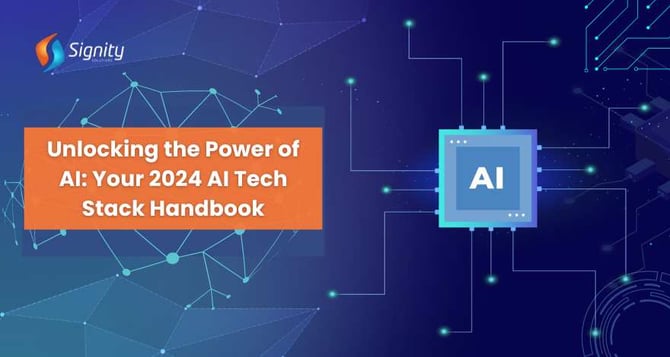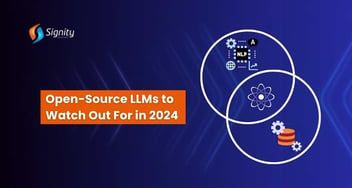Unlocking the Power of AI: Your 2024 AI Tech Stack Handbook
Looking for a holistic blog on AI stacks? This blog aims to give you complete clarity regarding the definition, evolution, frameworks, layers, and emerging trends of Generative AI tech stacks. It will also aid you in understanding the factors to consider while choosing AI stacks, which can be unnerving.

Artificial intelligence (AI) is rapidly transforming industries, and building efficient AI solutions requires a robust foundation. This foundation is the AI tech stack, a comprehensive set of tools and technologies that empower you to develop, deploy, and manage intelligent applications.
This blog post serves as your handbook for navigating the AI tech stack landscape in 2024. We'll explore the various layers, key components, and emerging trends that shape the future of AI development. Whether you're a seasoned developer or just starting your AI journey, this guide will provide valuable insights to help you leverage the power of AI for your business.
Key Takeaways
- An AI tech stack is a collection of tools and frameworks that aid in developing an AI application.
- The development of an AI tech stack involves different levels, such as infrastructure, model, and application.
- Various frameworks, such as Langchain, Haystack, and Huggingface, are available on the market for building an AI stack.
- There are certain factors you need to consider while choosing the right AI stack for your business.
What is an AI Tech Stack?
Imagine an AI Tech Stack as the foundation and building blocks for intelligent applications. It's a comprehensive set of tools and technologies, encompassing hardware, software, frameworks, and libraries, that empowers you to develop and deploy AI solutions.
With the right tech stack, you can construct a wide range of AI applications, from chatbots and recommendation systems to more complex tasks like medical diagnosis or self-driving cars.
Different Layers of a Generative AI Tech Stack
Companies that leverage a robust AI Tech Stack can achieve an average of 20% improvement in operational efficiency, as reported by a recent Forrester study. Here's a breakdown of the core layers that make up a generative AI tech stack, starting from the foundation:
Hardware Layer -
This layer focuses on optimizing the hardware for running the complex computations involved in the generative AI models. Here's what it entails:
-
Specialized Processors: Graphics Processing Units (GPUs) and Tensor Processing Units (TPUs) are crucial components in this layer. These processors are specifically designed to accelerate the computations required for training and running generative models efficiently.
-
Hardware Innovation: Cutting-edge hardware advancements in this layer can be a key differentiator for your generative AI tech stack's performance. It is crucial to stay updated on new hardware capabilities and their potential for generative AI.
If this layer is faulty, then the algorithms will not be able to perform to their fullest. It optimizes the hardware and trains complex neural networks. It may sometimes contain specialized chips and new innovations and might be the key differentiating factor in your AI tech stack.
Cloud Computing -
This layer acts as a powerful support system for developing and deploying AI solutions. Cloud platforms offer amazing processing capabilities, vast storage capacities, and a wide range of networking facilities. This allows AI developers to experiment with new technologies, work with massive datasets, and deploy complex neural networks on AI models. Cloud computing also plays a significant role in democratizing AI development by making these resources accessible and cost-effective for a wider range of users.
AI- ML Frameworks -
This layer provides the tools and libraries that AI developers use to implement AI and machine learning algorithms. Frameworks like TensorFlow and PyTorch offer functionalities for:
- Designing APIs: APIs enable seamless interaction between algorithms and other components of the AI tech stack.
- Training AI models: Frameworks provide libraries and tools specifically designed for training models efficiently.
- Deployment: Frameworks can simplify the process of deploying trained models into production environments.
- Monitoring and Performance Tracking: Frameworks often offer tools to monitor model performance and track key metrics.
Service Layer -
Ready-to-use API algorithms could be a blessing in NLP (natural language processing) and even functionalities like image processing. It acts as a gulf between the AI ML processes and the application.
Ready to Unlock the Transformative Potential of AI in Your Business?
Our experts will analyze your needs and recommend the optimal AI Tech Stack for your project. Unlock Efficiency & Innovation Today!
Core Layers of the AI Tech Stack
The AI tech stack can be visualized as a layered structure, with each layer contributing to the overall functionality of the AI system. Here's a breakdown of the core layers:
Infrastructure Layer -
This layer forms the foundation, handling the heavy lifting of data processing and model training. It includes components like:
- High-performance computing resources (GPUs, TPUs): These specialized hardware components accelerate complex AI computations.
- Data storage: Robust storage solutions are needed to house massive datasets used for training AI models.
- Cloud computing platforms: Cloud infrastructure provides scalable and cost-effective resources for running AI workloads.
Model Layer -
This layer is the heart of the AI system, where the magic happens. It involves:
- Data pre-processing: Transforming raw data into a format suitable for model training.
- Model development and training: Choosing the right generative model architectures (e.g., GANs, VAEs) and training them on the prepared data.
- Model optimization: Fine-tuning models to improve efficiency and reduce resource consumption.
Application Layer -
This layer bridges the gap between the AI model and the real world. It focuses on:
- Model Deployment: Integrating the trained model into applications or APIs.
- User Interface Design: Creating intuitive interfaces for users to interact with the AI application.
- Model Monitoring and Evaluation: Tracking and analyzing the performance of the deployed model.
Components of An AI Tech Stack and Their Significance
User Interface:
This layer determines how the different AI components will be developed and also contains a set of instructions regarding how the end users will interact with the AI application. This layer has two major components: AI applications and Visualization tools. While AI applications work in integrating artificial intelligence into workflows and automating processes, visual tools (like dashboards, business intelligence tools, etc.) help make insights easily decipherable to the audience.
Programming Language:
The language you choose provides the foundation for building your AI models. Python's extensive libraries, such as NumPy, Pandas, and Scikit-learn, coupled with its readability, make it a popular choice for AI development.
Frameworks:
Users need to select a framework that serves not only as a library but also as an entire bedrock of the AI stack. The list includes some of the popular names in this domain, such as Caffe, TensorFlow, Kera, Pytorch, etc. Frameworks provide all the tools and facilities needed to optimize and deploy AI models.
Runtime Environment:
The runtime environment is crucial to AI stack development for various reasons. One is that deep learning models need infrastructure to run properly, which the runtime environment provides. Popular options like Docker and TensorFlow Serving ensure scalability, security, and optimal performance for your AI applications.
Databases:
While developing an AI tech stack, you may create different kinds of data, such as user data, boolean data, categorical data, and operational data. A good database serves as the storehouse for these other data elements and also maintains a data repository from which data retrieval is seamless.
Servers:
For training and running AI applications, a lot of computational power is required, which can be provided by only a good server connection. The AI service should have minimal downtime so that its services can be accessed properly. Also, a lot of sensitive data needs to be protected, and an efficient server needs to take care of the firewall, sign-ins, and encryptions.
By carefully selecting and integrating these components, you can build a robust and efficient AI Tech Stack that empowers your AI development goals.
Generative AI Frameworks w.r.t. AI Stack Layer
Langchain:
Langchain is a revolutionary tool for anybody who wants to develop applications enabled by LLMS. It helps in building very secure and reliable applications. You can connect external data sources pretty easily, and integration with LLMs is seamless. Langchain is an open-source framework for Generative AI licensed by the Massachusetts Institute of Technology and has also been used to build chatbots.
Hugging Face:
If the democratization of AI is your primary goal, then Hugging Face is the framework that you should choose. It is a pre-trained model founded in 2016. It comes equipped with a ‘Transformers Library’ containing easily accessible NLP models, a “model hub” containing thousands of data templates and models, and tokenizers that convert simple text into machine-learning code formats, which are then deciphered by AI developers and tech enthusiasts.
Haystack:
It is an open-source Python framework perfect for working with LLMs. You can develop comprehensive NLP tools. It is an end-to-end solution that enables umpteen functionalities, such as fine-tuning an LLM, developing an evaluation system, or creating dynamic LLM templates.
LlamaIndex:
This framework, also known as RAG, connects data sources to large language models. It was initially referred to as the GPT index. It works by first assimilating (ingesting) the data from various sources, structuring the data so that the LLMs can decipher it easily, and then simplifying the entire integration process.
Jarvis:
It is a unit-testing framework that involves four fundamental steps: planning the task, selecting the AI model, carrying out the task, and finally generating the output. It enables users to use many sophisticated models to develop conversational AI applications.
Do You Need More Layers In An AI Stack?
The concept of adding new layers to the AI Tech Stack is gaining traction. Experts like Michael Zeller propose layers for functionalities like:
- Data Prompting: Providing specific instructions or examples to guide the AI model during training for improved accuracy.
- Model Orchestration: Managing the workflow of multiple AI models working together for complex tasks.
- Model Assessment: Implementing robust methods for evaluating the fairness, bias, and explainability of AI models.
These additional layers can enhance the overall effectiveness and reliability of AI systems.
Don't Know Where to Start?
Our AI consulting experts will assess your needs, define your AI strategy, and recommend the ideal tech stack to achieve your goals.
How Do You Select the Perfect AI Stack for Your Business?
Currently, Nykaa is at the top of the game with a tech stack consisting of languages like HTML, jQuery, React, and Javascript. Choosing the right AI Tech Stack can be a complex task. Here's how we can help you navigate the challenges:
- Understanding Your Needs: We work closely with you to identify your specific business goals and project requirements. This ensures the chosen stack aligns perfectly with your unique use case.
- Balancing Scalability & Agility: We recommend a stack that can scale efficiently as your data volumes and user base grow. Our solutions also prioritize flexibility to adapt to evolving AI advancements and user feedback.
- Security & Compliance: We prioritize robust security measures throughout the stack to protect sensitive data and ensure adherence to relevant regulations.
- Expertise & Ongoing Support: Our team of AI experts possesses deep knowledge of various AI Tech Stack components. We provide comprehensive support throughout your AI development journey, from choosing the right stack to deployment and optimization.
By leveraging our expertise, you can overcome the challenges of selecting the perfect AI Tech Stack and unlock AI's full potential for your business.
Also Read: Top 15 Artificial Intelligence Applications in 2024
Future Trends In AI Stack Development
A lot of trends are already emerging with respect to AI tech stacks due to newly-found horizons in AI research, ever-changing business needs, and knowledge-hungry tech enthusiasts. Here’s a countdown of the most likely trends that will dominate the AI industry in the coming years-
Explainable AI -
Although artificial Intelligence is a fairly popular name today, many people have yet to warm up to the innovations and technologies associated with it. Explainable AI or XAI helps users understand the logic behind the outputs and decisions generated by artificial intelligence systems, which helps build trust and authenticity.
Federated Learning -
Imagine training the AI models directly on the device you use in everyday life, like your IOT/Android device. This is so very important when you feel the need to store your private data. Google coined this term in 2016. Unless the user shares their work system with the centralized server, it is very difficult for miscreants to find a loophole in this system.
RPA or Robotic Process Automation -
Have you ever heard of automated workflows that skyrocket your organizational productivity and interact with the software just like humans do? That’s exactly what RPA is about. The most important benefits of RPA implementation are that it reduces human errors by more than 55% and responds to changes in user interactions in seconds.
AI Ethics and Responsible AI -
This framework ensures that everything, from the development, deployment, and use of AI applications, is based on certain ethical principles. Thus, the whole process is transparent and fosters authenticity. The decisions prioritize human needs and the welfare of the masses and harbor authenticity.
In an era where over 77% of companies are actively using or looking to explore the possibilities in AI, ethical AI practices are the need of the hour.
Quantum AI -
Quantum AI is an amalgamation of artificial intelligence and Quantum computing. It leverages the principles of quantum mechanics, and one of the most important components of quantum AI is Quantum entanglement, which leads to more secure applications. While traditional AI uses bits, Quantum AI utilizes qubits, which are in a state of superposition, leading to exceptional computational power.
Related Read: How to Choose the Best AI Company?
What Next?
In order to get started with AI tech stack development, it is very important to know what is the appropriate stack AI for your enterprise. The best way to get a handle on it is to contact an AI consulting company like Signity Solutions and avail of their AI development services.
An AI consulting company can also help with areas like risk mitigation and scalability. Signity’s adherence to providing businesses with end-to-end solutions is evident from its stellar clientele and client testimonials.



.png?width=344&height=101&name=Mask%20group%20(5).png)
















